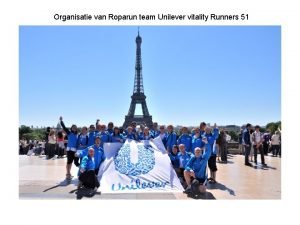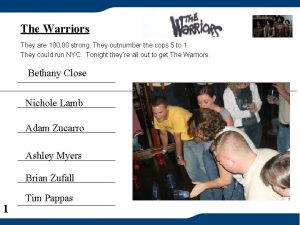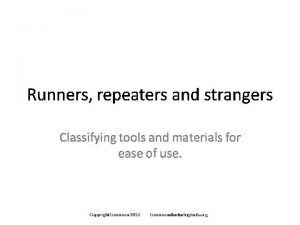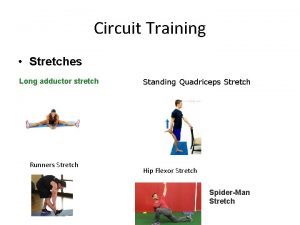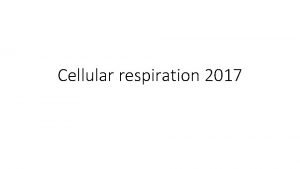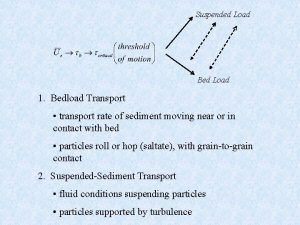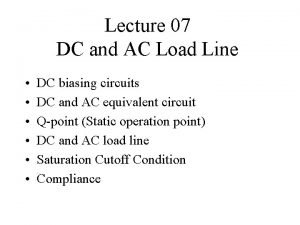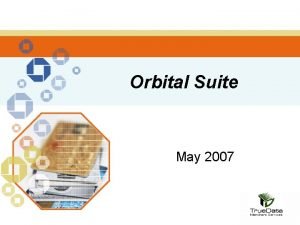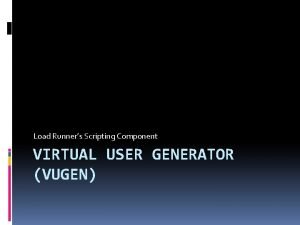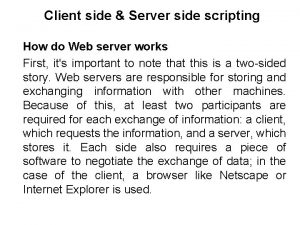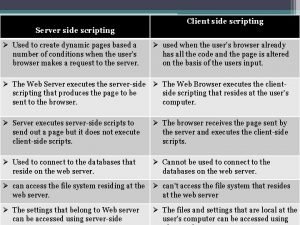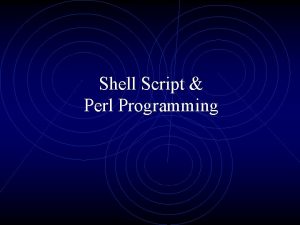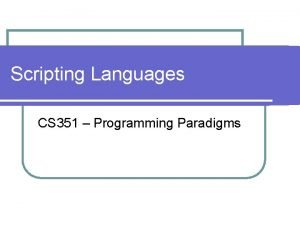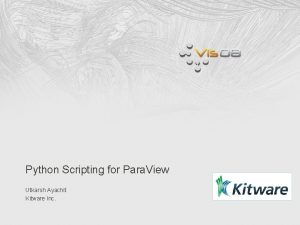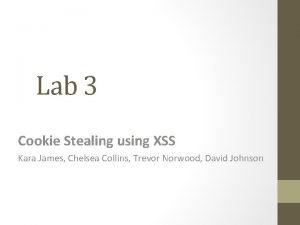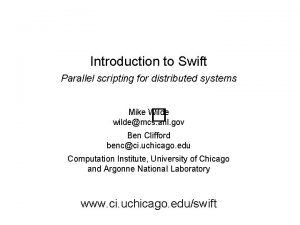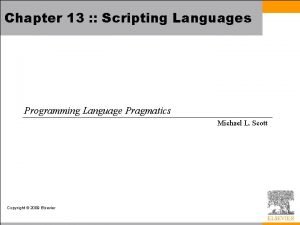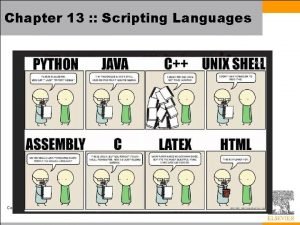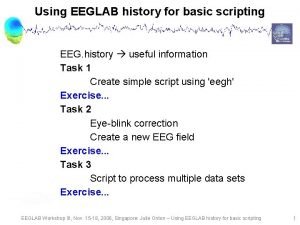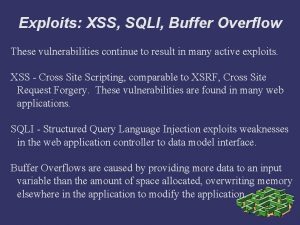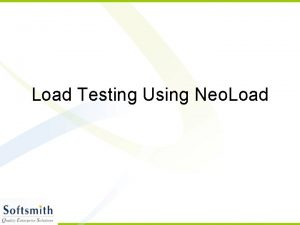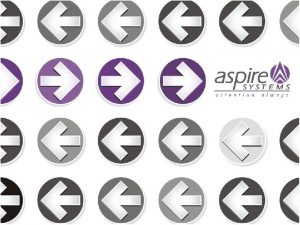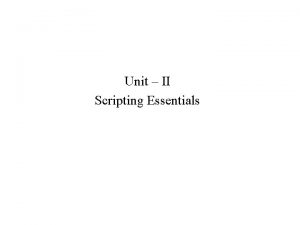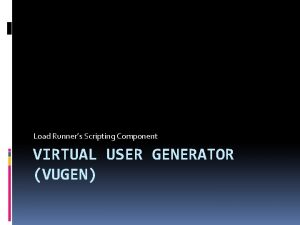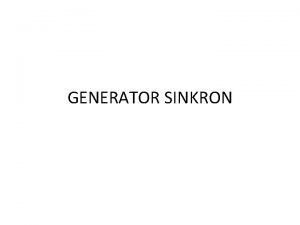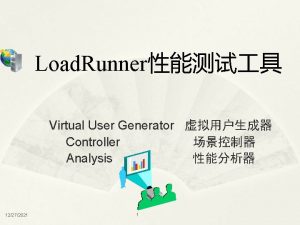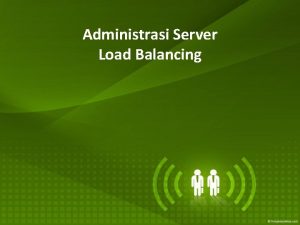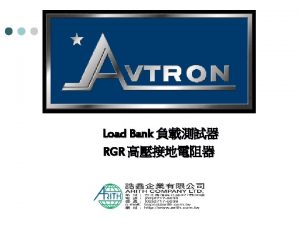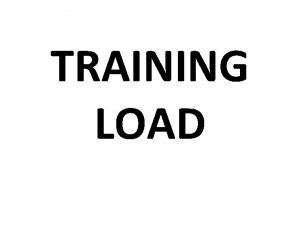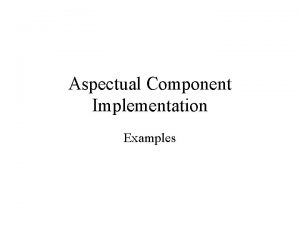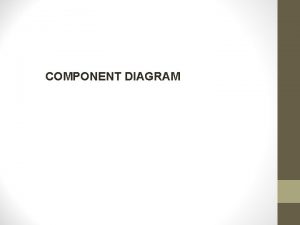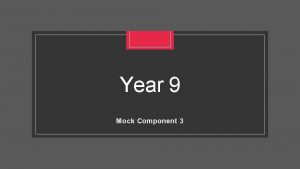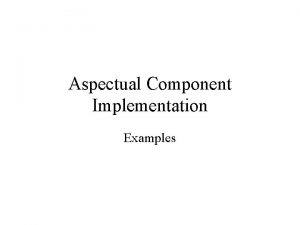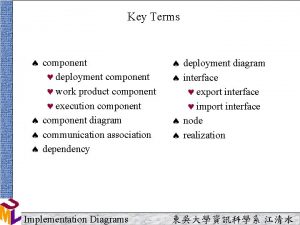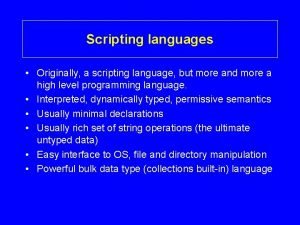Load Runners Scripting Component VIRTUAL USER GENERATOR VUGEN















































- Slides: 47

Load Runner’s Scripting Component VIRTUAL USER GENERATOR (VUGEN)

HOW IT WORKS

Load. Runner Internal Architecture

Driver process Mdrv. exe - Multi-threaded Driver Process r 3 vuser. exe - emulate application clients such as Internet Explorer web browser performs 3 main actions: Kill> cpp (C language pre-processor) cci (C pre-compiling) which creaes a file with ci file, and execute using the driver for the protocol technology being tested.

How to Run Vuser Script using Command From a Command Prompt mdrv program runs a single instance of the script without the user interface. <installation_dir>/bin/mdrv. exe -usr <script_name> -vugen_win 0 You can specify arguments to pass to your script by using the following format: script_name -argument_value Example: specify the load generator, as well as indicate the number of times to run the script 1 -host pc 4 -loop 5 From a Linux command line run_db_vuser. sh <commands> script_name. usr For example, the following command line executes a Vuser script called test 1, and places the output file in a folder called results 1 run_db_vuser. sh-out /u/joe/results 1 test 1. usr

Supported Protocols A protocol acts as a communication medium between a client and a server.

Supported Protocols (Classification) Technology Protocols Documents . NET Database Oracle (2 -Tier) ODBC DCOM COM/DCOM Network Domain Name Resolution (DNS) LDAP FTP IMAP MAPI Post Office Protocol (POP 3) Simple Mail Transfer Protocol (SMTP) Tuxedo Windows Sockets Oracle NCA Oracle Web Applications 11 i (Click and Script) People. Soft-Tuxedo People. Soft Enterprise (Click and Script) Siebel-Web Remote Access Citrix ICA RTE (Remote Terminal Emulator) Rich Internet Applications Flex (for Adobe® Flash) AJAX Click and Script AJAX Tru. Client Silverlight Oracle E-Business SOA Web Services Web and Multimedia MMS (Media Player) Web (Click and Script) Web (HTTP/HTML) Wireless MMS (Multimedia messaging service) GUI Virtual Users HP Functional Testing (Quick. Test Professional) Java Record/Replay Java over HTTP Java Record Replay Remote Desktop Microsoft Remote Desktop (RDP) SAP-Web SAP Click and Script SAP GUI Templates EJB C Vuser Javascript Vuser VBScript Vuser

Recording Scripts

Providing Authentication Information

Recording via a Proxy record scripts using a Load. Runner proxy to resolve situations where you cannot install Vu. Gen on the client machine. the Vu. Gen machine acts as a proxy server capturing all the traffic from the client machine to the target server. You can only create a Web - HTTP/HTML script when recording via a proxy

Recording Options General > Scripting Language and options The default script generation language is C or C# for MS. NET. which protocols are appropriate for each language: C. For recording applications that use complex COM constructs and C++ objects. C #. For recording applications that use complex applications and environments (MS. NET protocol only). Visual Basic. NET. For VB. NET applications using the full capabilities of VB. Visual Basic Scripting. For VBscript-based applications such as ASP. Java Scripting. For Javascript-based applications such as js files and dynamic HTML applications. If the recorded think time is less than the threshold, Vu. Gen does not generate a think time statement. If you disable this option, Vu. Gen will not generate any think times. Use this option if Vu. Gen is unable to record your application. Your application may block access to Vu. Gen, and recording with this option selected may enable access.

Recording Options Recording Levels By selecting a recording level, you specify what information to record and which functions to use when generating a Vuser script GUI-based Script Records HTML actions as context sensitive GUI functions. HTML-based Script Generates a separate step for each HTML user action. The steps are intuitive, but they do not reflect true emulation of the Java. Script code. It does not record all resources during the recording session, but downloads them during replay. URL-based Script Records all browser requests and resources from the server that were sent due to the user's actions. Many Web pages contain non-HTML elements, such as applets, XML, Active. X elements, or Java. Script. These non-HTML elements usually contain or retrieve their own resources. Recommended for most applications, including those with Java. Script, People. Soft Enterprise and Oracle Web Applications. Default recording level for Web (HTTP/HTML) Vusers. Recommended for Browser applications. Recommended For non browser applications. i. e. web_browser, web_edit_field, web_text_link. web_url for a URL in the Address field on the internet browser. web_link for clicking a text link between <a href=. . . > and <a> web_image for clicking an HTML <img href= link. web_submit_form for pressing "submit" of a GET or PUT form obtained in the context of a previous operation — perhaps recorded by Vu. Gen in HTML-based recording mode. web_submit_data for pressing "submit" of a GET or PUT form without the context of a previous operation — perhaps recorded by Vu. Gen in URL-based recording mode or in HTML-based recording mode with the "A script containing explicit URLs only" option checked. URL steps (web_url statements), or in the case of forms, as web_submit_data. It does not generate the web_link, web_image, and web_submit_form functions, nor does it record frames. Very Intuitive and easy to understand Not as Intuitive and easy to understand Scalable More scalable and effective for creating a load test

Recording Options Recording Levels – HTML based If you checked it, you will invoke URLbased script recording of only web_url or web_submit_data functions, not web_link or web_image functions or Non-HTML elements which include applets, XML, Active. X elements, or javascript. Creates a new function for each one of the non HTML-generated resources and does not include them as items in the page's functions (such as web_url and web_link). All of the web_url functions generated for a resource are placed in a concurrent group (surrounded by web_concurrent_start and web_concurrent_end). Does not generate a new function for each of the non HTML-generated resources. It lists all resources as arguments of the relevant functions, such as web_url, web_link, and web_submit_data. The resources, arguments of the Web functions, are indicated by the EXTRARES flag.

Recording Options HTTP Properties - Advanced more accurately emulate a new user beginning a browsing session. This option resets the HTML context, so that a context-less function is always recorded in the beginning of the action. It also clears the cache and resets the user names and passwords. Saves a local copy of the snapshot resources during record and replay, thereby creating snapshots more accurately and displaying them quicker. enable this option only on non-English UTF-8 encoded pages. The recorded site's language must match the operating system language. Vu. Gen replaces the identified server names and IP addresses with parameters. Parameterizing server names and IP addresses enables you to run the Vuser script in different environments by simply changing the server and IP address values in the parameter file. If you are using Japanese Windows, select this option to enable support for Web sites that use EUC-JP character encoding. This instructs Vu. Gen to convert EUC-JP strings to the encoding of your locale's machine in order to display them properly in Vu. Gen converts all EUCJP (Japanese UNIX) strings to the SJIS (Japanese Windows) encoding of your locale's machine, and adds a web_sjis_to_euc_param function to the script. (Kanji only) When you record a script, Vu. Gen indicates whether or not it will retrieve the resource during replay using the Resource attribute in the web_url function. If the Resource attribute is set to 0, the resource is retrieved during script execution. If the Resource attribute is set to 1, the Vuser skips the resource type. specify the type of the content you want to record or exclude from your script. Enables you to automatically send additional HTTP headers with every HTTP request submitted to the server.

Recording Options Port Mapping Scripts that record network traffic on a socket level (HTTP, SMTP, POP 3, FTP, IMAP, Oracle NCA and Win. Sock). You can map the traffic from a specific server: port combination to the desired communication protocol. By default, no mappings are defined and Vu. Gen employs auto-detection. In certain instances, however, Vu. Gen may be unable to recognize the protocol. For example: • The protocol signature closely resembles an existing protocol, resulting in erroneous processing. • There is no unique signature for the protocol. • The protocol uses SSL encryption, and therefore cannot be recognized on a Win. Sock level. In all of the above cases, you can supply information to uniquely identify the server and port hosting the protocol. The level of data to capture (relevant only for HTTP based protocols): Socket level data. Capture data using trapping on the socket level only. Port mappings apply in this case (default). Win. INet level data. Capture data using hooks on the Win. INet. dll API used by certain HTTP applications. The most common application that uses these hooks is Internet Explorer. Port mappings are not relevant for this level. Socket level and Win. INet level data. Captures data using both mechanisms. Win. INet level sends information for applications that use Win. INet. dll. Socket level sends data only if it determines that it did not originate from Win. INet. dll. Port mapping applies to data that did not originate from Win. INet. dll.

Synchronous Vs Asynchronous Communication Applies to Web (HTTP/HTML), Mobile Application - HTTP/HTML, Flex, and Web Services Vuser scripts. Web-based applications can exhibit synchronous behavior, asynchronous behavior, or a combination of both. Asynchronous applications enable a client to be notified whenever an event occurs on the server side. therefore better able to update information as required. A typical synchronous conversation includes the following steps: 1. 2. 3. The user interacts with an application that is presented in a web browser. Based on the user input, the browser submits a request to the web server. The server sends a response to the request, and the application in the browser is updated. Asynchronous communication occurs in parallel (simultaneously) with the main, synchronous flow. Comprised of various request and response sequences.

Types of Asynchronous Communication Polling - browser sends HTTP requests to the server at regular intervals, for example, every 5 seconds. The server responds with updates. Long-Polling - The client generates an HTTP request to a known address on the server. Whenever the server has an update, it responds with an HTTP response. Immediately after receiving the server response, the client issues another request. Push - The client opens a connection with the server by sending a single HTTP request to a known address on the server. The server then sends a response that appears to never end, so that the client never closes the connection. Whenever necessary, the server sends a “sub message” update to the client over the open connection.

How to Create an Asynchronous Vuser Script Async functionality is not supported when you replay a Vuser script in Win. INet mode. Async Scan - to scan the Vuser script after recording, locate asynchronous communication, and insert the appropriate asynchronous functionality. Network traffic that the asynchronous functions generate runs in parallel – simultaneously – with the main flow in the Vuser script. web_reg_async_attributes - registers the next action function as the beginning of an asynchronous conversation, and defines the behavior of the asynchronous communication. relevant callback implementations in the Async. Callbacks. c extra file web_stop_async - cancels the specified asynchronous conversation, including all its active and future tasks. web_sync - suspends the Vuser script execution until the specified parameter is defined. web_util_set_request_url - sets the specified string to be the request URL for the next request sent in the conversation. Applicable only when called from a callback. web_util_set_request_body - sets the specified string to be the request body for the next request sent in the conversation. Applicable only when called from a callback. web_util_set_formatted_request_body - included as part of a Flex protocol asynchronous conversation instead of a Web(HTTP/HTML) protocol. expects an XML formatted request body, which will be converted before the request is sent.

Correlating Asynchronous Vuser Scripts Due to asynchronous nature, dynamic values from asynchronous communication cannot be handled by Design Studio, and must be correlated manually. lr_save_param_regexp - called from a callback to extract the necessary value from server response (Response. CB) or response buffer (Response. Body. Buffer. CB)

Callbacks : Async. Callbacks. c extra file Request. CB - called before a request is sent. Response. Body. Buffer. CB - called when there is content in the response body buffer and at the end of the response body. Generated automatically for push-type conversations, but is available for poll and long-pole conversations as well. Response. CB - called after every response is received in the conversation.

Async Scan Rules Vu. Gen may fail to correctly identify some of the asynchronous conversations. Async rules can be positive or negative. Positive: When Vu. Gen fails to identify asynchronous conversations that are included in a Vuser script, implement a positive Async rule to enable Vu. Gen to identify the asynchronous behavior. Scenario: Vu. Gen does not identify URLs under http: //www. trueasync. com/push_example. aspx as push asynchronous conversations, and you know that they are part of push asynchronous conversations. Add a positive rule to enable Vu. Gen to correctly identify the push asynchronous conversations. Negative: When Vu. Gen erroneously classifies regular synchronous steps as part of an asynchronous conversation, implement a negative Async rule to prevent Vu. Gen from erroneously identifying asynchronous behavior. Scenario: Vu. Gen identifies all URLs under http: //www. not-async. com/ as asynchronous poll conversations. You know that these are not asynchronous conversations. Implement a negative Async rule to prevent Vu. Gen from erroneously identifying asynchronous behavior.

Directory Structure

Directory Structure Different File Formats The Data folder stores all of the recorded data used primarily as a backup. but you may want to keep it around if you use the graphical scripting mode and/or you want to compare playback vs. recording. The auto-correlation feature makes use of this data, too When Vu. Gen compiles a script, it creates a file named "pre_cci. ci“. Output from the C pre-processor, which contains all of the functions used in your scrip, from all of the Acitons and header files. The Controller compiles these . ci files into machine opcode. Actions -are repeated for multiple iterations. Vusers are in "Running" status when executing this action. Vu. Gen allows only a single Action section for scripts using the COM/DCOM and Java protocols (only have an action section, containing init, action, and end classes of code) vuser_end - for Vuser logoff. Run once per user. Vusers are in "Exiting" status when executing this action. vuser_init - for initializing a Vuser. Run once per user. Vusers are in "Init" status when executing this action. Invokes VUGEN. defines which actions are used by the script. There are other properties which define which protocols are used and other settings. Example : [General] Type=Oracle_NCA Default. Cfg=default. cfg Build. Target= Param. Right. Brace=> Param. Left. Brace=< New. Function. Header=0 Major. Version=5 Minor. Version=0 Parameter. File=nca_test 3. prm Global. Parameter. File= [Transactions] Connect= [Actions] vuser_init=init. c Actions=run. c vuser_end=end. c Compilation logs Containes the parameter definitions Includes command line parameters to the preprocessor. Contains the run logic for the script. Header Files recorded for web_custom_request functions. Run-Time Settings (think time, iterations, log, web, Data Files except for run-logic) Example : [General] Xl. Bridge. Timeout=120 [Think. Time] Options=NOTHINK Factor=1 Limit. Flag=0 Limit=1 [Iterations] Num. Of. Iterations=1 Iteration. Pace=Iteration. ASAP Start. Every=60 Random. Min=60 Random. Max=90 [Log] Log. Options=Log. Brief Msg. Class. Data=0 Msg. Class. Parameters=0 Msg. Class. Full=0

The Script Cleaning Up Files When Vu. Gen runs, it creates a data folder with a lot of "cruft" files. When a script is saved as a new name by Vu. Gen, only files it knows about are copied to the new folder: . usr, . c, . prm, and. dat files. This Windows batch file deletes extraneous files that are regenerated by Vu. Gen during each compilation, so do not need to be kept: rem cd %1 del /q pre_cci. c del /q *. log never need to look at del /q *. txt \ These text files contain commands and arguments for the script compiler and driver (mdrv) and are created dynamically, so you can safely delete them. del /q *. ci del /q *. bak del /q *. class del /q *. sed del /q *. idx \ binary "index" files created by Vugen for holding parameter values rem del /q *. dat del combined_*. c rd /q /s data pause You may also want to delete the default "result 1" folder and other result folders you created. \ random log files which you will probably \A list of #includes for all of your Actions There is a quick shortcut you can use, rather than going through and deleting everything manually. From the 'File' menu, select ‘Manage Zip Files' and 'Export to zip file'. In the dialog, select the 'Runtime files' radio button and 'Ok'. Now you have a "clean" script without the extraneous files created by Vugen.

Enhancing Recorded Script

Parameterization Parameter Types File - Data files can be local or global. You can specify an existing ASCII file, use Vu. Gen to create a new one, or import a database file. Data files are useful if you have many known values for your parameter. Table - meant for applications that you want to test by filling in table cell values. Whereas the file type uses one cell value for each parameter occurrence, the table type uses several rows and columns as parameter values, similar to an array of values. Using the table type, you can fill in an entire table with a single command. XML - You can use an XML type parameter to replace the entire structure with a single parameter. For example, an XML parameter called Address can replace a contact name, an address, city, and postal code. use XML parameters with Web Service scripts or for SOA services. Internal - generated automatically while a Vuser runs, such as Date/Time, Group Name, Iteration Number, Load Generator Name, Random Number, Unique Number, and Vuser ID. User-Defined Function – A user-defined function replaces the parameter with a value returned from a function located in an external DLL. Before you assign a user-defined function as a parameter, you create the external library (DLL) with the function. The function should have the following format: __declspec(dllexport) char *<function. Name>(char *, char *) examples of user-defined functions: __declspec(dllexport) char *UF_Get. Version(char *x 1, char *x 2) {return "Ver 2. 0"; } __declspec(dllexport) char *UF_Get. Current. Time(char *x 1, char *x 2) { time_t x = tunefully); static char t[35]; strcpy(t, ctime( =; x)); t[24] = '�'; return t; }

Parameterization When out of values If you chose Unique as the data assignment method the When out of values and Allocate Vuser values in the Controller options become enabled. • When out of values. Specify what to do when there is no more unique data: Abort Vuser, Continue in a cyclic manner, or Continue with last value. • Allocate Vuser values in the Controller (for Load. Runner users only). Indicate whether you want to manually allocate data blocks for the Vusers. You can allow the Controller to automatically allocate a block size or you can specify the desired number of values. Select Automatically allocate block size or Allocate x values for each Vuser For the second option, specify the number of values to allocate. r.

Parameterization Data Assignment and Update Methods for File/Table/ XML Parameters Update Method Data Assignment Method Sequential Random Each iteration The Vuser takes the next value from the data table for each iteration. The Vuser takes a value from the new random value next unique from the data position in the table for each data table for each iteration. Each occurrence (Data Files only) The Vuser takes the next value from the data table for each occurrence of the parameter, even if it is within the same iteration. The Vuser takes a new random value from the data table for each occurrence of the parameter, even if it is within the same iteration. The Vuser takes a new unique value from the data table for each occurrence of the parameter, even if it is within the same iteration. The value assigned in the first iteration is used for all subsequent iterations for each Vuser. The random value assigned in the first iteration is used for all iterations of that Vuser. The unique value assigned in the first iteration is used for all subsequent iterations of the Vuser. Once Unique Vuser Behavior in the Controller settings: Select next row = Unique Update Value on = Each iteration When out of values = Continue with last value Situation Duration Resulting Action When the unique values are finished, each Vuser More Run until continues with the last value, but a warning iterations completion message is sent to the log indicating that the values than values are no longer unique. Vusers take all of the unique values until they are finished. Then the test issues an error message Error: Insufficient records for param More Run <param_name> in table to provide the Vuser with Vusers than indefinitely or unique data. To avoid this, change the When out values Run for. . . of values option in the Parameter properties or the Select next row method in the Parameter properties. One of two Run The parameter that ran out of values, continues in a parameters indefinitely or cyclic manner until the values of the second are out of Run for. . . parameter are no longer unique. values

Correlation Types – Design Studio uses three processes to automatically find dynamic values. 1. Rules - first scans for dynamic values that are defined by rules 2. Record - Design Studio scans for dynamic values after code generation. 3. Replay - scans for dynamic values after replay. This method may need to be repeated several times.

Debugging Features Select Replay > Run Step by Step enables you to follow the script execution one line at a time. Click Replay > Animated Run highlights the line that is running in the Vuser script. Breakpoints pause script execution at specified points in the script. Bookmarks navigate between the bookmarks to help analyze and debug your code. View > Debug > Watch enables you to monitor variables and expressions while a script runs. Go To o using breakpoints, you can use the Go To Source o using bookmarks, you can use the Next Bookmark and Previous Bookmark o to examine the Replay log messages for a specific step or function, right-click the step in the Editor and select Go To Step in Replay Log ci_set_debug(ci_this_context, int debug, int trace); allows trace and debug to be turned on and off at specific points in the script. For example- o ci_set_debug(ci_this_context, 1, 1) /* turn ON trace =; debug */ o ci_set_debug(ci_this_context, 0, 0) /* turn OFF trace =; debug */ Replay Output run-time settings options in Vu. Gen to select more extensive logging in order to obtain a more detailed log output. Note: The debugging features are available for C-based Vuser protocols. The features are not available for the VB Script Vuser protocol.

Controlling Message Display During a run, when a script fails a transaction and continues, how will you know which user failed? After each transaction failure, issue a message which contains information uniquely identifying the user involved. Load. Runner provides several functions to issue information during a run: // send a message to the output log prefixed with the action name and line number, lr_output_message("an output message"); An example: Actions. c (4): an output message // send a message to both the Output window and the Vuser log: lr_message("*** a message" +"r"+"A new line. " ); Arranging the "); " in an additional line makes it easier to add or remove items in the command. The "n" escape character adds a line break on UNIX/Linux machines. The "r" escape character adds a line break on Windows machines. // send a message to the output log without the action name and line number: lr_log_message("numbert"+ numvar +"t"); The "t" TAB escape character around a number separates it into different columns for import into Excel or for double-click selection in Notepad. // send a message only to the Controller Vuser status area (which appears only briefly when run in Vu. Gen): lr_vuser_status_message("a vuser status message"); // send a highlighted red message -17999 to the Load. Runner Controller or Tuning Module Console's Output window: lr_error_message("an error message");

Error Handling By default, when a Vuser detects an error, the Vuser stops executing the script Continue on Error run-time setting applies to the entire Vuser script. lr_continue_on_error function enables you to control error handling for a specific segment of a Vuser script. Overrides the Continue on Error run-time setting for a portion of a script. To mark the segment, enclose it with lr_continue_on_error(1); and lr_continue_on_error(0); Example – lr_continue_on_error(1); web_link("EBOOKS", "Text=EBOOKS", "Snapshot=t 2. inf", LAST); web_link("Find Rocket e. Books", "Text=Find Rocket e. Books", "Snapshot=t 3. inf", LAST); lr_continue_on_error(0);

Run-Time Settings General : Run Logic When you run multiple iterations of a Vuser script, only the Actions sections of the script are repeated—the vuser_init and vuser_end sections are not repeated.

Run-Time Settings General : Pacing Allows you to control the time between iterations.

Run-Time Settings General : Log Disabling this options only affects automatic logging and log messages issued through lr_log_message. Messages sent manually, using lr_message, lr_output_message, and lr_error_message, are still issued. to configure the log cache size. If the contents of the cache exceed the specified size, Vu. Gen deletes the oldest items. Includes warnings and other messages to standard log. Logs all parameters assigned to the script along with their values. Logs all of the data returned by the server. Logs all of the functions and messages sent by the Vuser during the session.

Run-Time Settings General : Think Time replay the script ignoring all lr_think_time functions. example, lr_think_time(10) waits ten seconds. use a multiple of the recorded think time Limit the think time's maximum value.

Run-Time Settings General : Additional Attributes You specify command line arguments that you can retrieve at a later point during the test run, using lr_get_attrib_string. Using this node, you can pass external parameters to prepared scripts.

Run-Time Settings General : Miscellaneous Mark all transactions in which an lr_error_message function was issued, as Failed. The lr_error_message function is issued through a manually defined If statement. See the snapshot by viewing the Vuser Log and double-clicking on the line at which the error occurred. not recommended enabling both the Continue on Error and Generate Snapshot on Error options in a load test environment. This configuration may adversely affect the Vusers' performance. driver program (mdrv. exe or r 3 vuser. exe) is launched (and loaded) into the memory again and again for every instance of the Vuser. Loading the same driver program into memory uses up large amounts of RAM (random access memory) and other system resources. This limits the numbers of Vusers that can be run on any load generator. Controller launches only one instance of the driver program (such as mdrv. exe), for every 50 Vusers (by default). This driver process/program launches several Vusers, each Vuser running as a thread. These threaded Vusers share segments of the memory of the parent driver process. This eliminates the need for multiple reloading of the driver program/process saves much memory space, thereby enabling more Vusers to be run on a single load generator. to generate breakdown data for diagnostics (J 2 EE) during the scenario run, do not use automatic transactions.

Run-Time Settings Browser : Browser Emulation Node Even if you disable this option, each resource is only downloaded once for each page, even if it appears multiple times. cache only the URLs that require the HTML content Allows you to specify addiitonal (non- html) content types that you want to store in the cache. To maintain a smaller memory footprint for the virtual users, keep this option disabled Vu. Gen adds the "If-modified-since" attribute to the HTTP header. This option brings up the most recent version of the page, but also generates more traffic during the scenario or session execution. By default browsers does not check. reset all HTTP contexts between iterations to their states at the end of the init section. deletes all cookies, closes all TCP connections (including keep-alive), clears the emulated browser's cache, resets the HTML frame hierarchy (frame numbering will begin from 1) and clears the user-names and passwords. (Enabled by default) Note: Async conversations are terminated at the end of each iteration even if this setting is disabled. load graphic images when accessing a Web page during replay. both graphic images that were recorded with the page, and those which were not explicitly recorded along with the page. enable this option if you are trying to test the entire system, including end-user time. Clear the check box to use the information stored in the browser's cache, simulating a user who recently visited the page.

Run-Time Settings Internet Protocol : Content. Check This is useful for detecting non-standard errors. The standard error pages are recognized by Vu. Gen and treated as errors, causing the script to fail. Some application servers, however, issue their own error pages that are not detected by Vu. Gen as error pages. Example- suppose that your application issues a custom page when an error occurs, containing the text ASP Error. You instruct Vu. Gen to look for this text on all returned pages. When Vu. Gen detects this string, it fails the replay. Note: Vu. Gen searches the body of the pages—not the headers.


Run-Time Settings Internet Protocol : Preferences perform verification checks during replay by executing the verification functions web_find or web_image_check. This option only applies to statements recorded in HTML-based mode. Vusers running with verification checks use more memory than Vusers who do not perform checks. collect data used to create Web Performance graphs. You view the Hits per Second, Pages per Second, and Response Bytes per Second (Throughput) graphs during test execution using the online monitors and after test execution using the Analysis. You view the Component Breakdown graph after test execution using the Analysis. Note: If you do not use the Web performance graphs, disable these options to save memory. Two HTTP replay engines: Sockets-based (default) or Win. Inet based. Win. Inet- is the engine used by Internet Explorer and it supports all of the features incorporated into the IE browser. Used when recording in NTLM, SOCKS proxy, or proxy automatic configuration environment. Not scalable and does not support Linux. when working with threads, does not accurately emulate the modem speed and number of connections. Vu. Gen's proprietary sockets-based replay - a lighter engine that is scalable for load testing. It is also accurate when working with threads. Does not support SOCKS proxy. Creates unique transaction names for automatic transactions by adding file name and line number in names. Requires more memory as it places more info in logs. Returns a warning (not error) for a function which failed on an item that is not critical such as an image or Java applet that failed to download. You can set a content-type to be critical by adding it to the list of Non-Resources in Recording Options > HTTP > Advanced > Non. Resources. Enable it only if you need a non critical failure should be treated as error and fail the test. Save resources used in snapshots on local machine. Which lets run-time viewer create snapshots more accurately and display them quicker.

Included in the HTTP request header whenever a Vuser sends a request to a Web server. Persistent or Continuous Connections. These long-lived HTTP sessions allow multiple requests to be sent over the same TCP connection. This improves the performance of the Web server and clients. The keep-alive option works only with Web servers that support keepalive connections. Timeouts provide an opportunity for the server to stabilize and respond to the user. emulate non-browser applications that do not include zlib headers in their requests by accepting compressed data, you may significantly increase the CPU consumption. To manually add compression, enter the following function at the beginning of the script: web_add_auto_header("Accept-Encoding", "gzip"); To verify that the server sent compressed data, search for the string Content -Encoding: gzip in the section of the server's responses of the replay log.

saves time in subsequent calls to the same server. In situations where the IP address changes, as with certain load balancing techniques, be sure to disable this option to prevent Vuser from using the value in the cache. Converts received HTML pages and submitted data from and to UTF-8. You enable UTF-8 support in the recording options. Issues a warning instead of an error when a timeout occurs due to a resource that did not load within the timeout interval. For nonresources, Vu. Gen issues an error. When expecting HTML, parse the response only when it is the specified content-type. If the server does not respond in a reasonable amount of time, check for other connection-related issues, rather than setting a very long timeout which could cause the scripts to wait unnecessarily. The time limit within which an entire step (script function) should complete, or else the function fails. This option can be used to emulate a user behavior of not waiting for more than x seconds for a page. If the size of the data is larger than the specified size, the server will send the data in chunks, increasing the overhead of the system. Print information about the NTLM handshake to the standard log. Print information about the SSL handshake to the standard log. Limits the number of error matches issued as ERRORS for content checks using a LB or RB (left boundary or right boundary). All subsequent matches are listed as informational messages. Store the values in the Content. Check XML file in UTF-8. Limit the number of request body bytes displayed in Tree-View. Set to zero (0) for no limit. time to wait (in milliseconds) between testing the condition that yields false and the next retry.

This think time will be included in the transaction time. Use full NTLM 2 handshake security instead of the more basic NTLM 2 session security response. Use the Microsoft Security API for NTLM authentication instead of the indigenous one. Use the credentials provided by the user at logon. Enable Kerberos-based authentication. When the server proposes authentication schemes, use Negotiate in preference to other schemes. Do not reuse credentials obtained in previous iterations. Enabling this setting will increase the load on the KDC (Key Distribution Server). To lower the load on the server, set this option to Yes in order to reuse the credentials obtained in previous iterations. This option is only relevant when Kerberos authentication is used.

Run-Time Settings Internet Protocol : Download Filters To include / exclude resources to be downloaded at replay from the specified URLs or Hosts.

C Programming A local C variable (such as int or char) created in the vuser_init section of the script (such as "int x") is not visible to other sections of the script. So create parameters that are global to all sections using the lr_save_string function. Example: char *itoa ( int value, char *str, int radix ); vuser_init(){ int x = 10; char buffer[10]; lr_save_string( itoa( x, buffer, 10) , "p. X" ); lr_message ( "int x = %s", lr_eval_string("{p. X}" )); return 0; }
 Vitality runners
Vitality runners Bow street runners definition
Bow street runners definition Theodore roosevelt contribution to forensic science
Theodore roosevelt contribution to forensic science Van cortlandt rangers
Van cortlandt rangers Pronto plates
Pronto plates Runners repeaters strangers
Runners repeaters strangers Adductor stretches for runners
Adductor stretches for runners Why do runners breathe heavily after a sprint race
Why do runners breathe heavily after a sprint race Bearing
Bearing Tributary load and load path
Tributary load and load path Pux
Pux Dc and ac load line
Dc and ac load line Falling load generator
Falling load generator Apa tujuan dari perancangan komponen antarmuka grafis
Apa tujuan dari perancangan komponen antarmuka grafis Difference between generator and manifesting generator
Difference between generator and manifesting generator Single user and multi user operating system
Single user and multi user operating system Rtos multitasking
Rtos multitasking Orbital payment processing
Orbital payment processing Has virtual functions and accessible non-virtual destructor
Has virtual functions and accessible non-virtual destructor Inventor scripting
Inventor scripting Language
Language Language
Language Loadrunner scripting language
Loadrunner scripting language Lab 7-7 shells scripting and data management
Lab 7-7 shells scripting and data management Gel script
Gel script Advantages and disadvantages of client side scripting
Advantages and disadvantages of client side scripting Client-side scripting examples
Client-side scripting examples Tabular editor perspectives
Tabular editor perspectives Elongday
Elongday Characteristics of scripting languages
Characteristics of scripting languages Sage 100 scripting
Sage 100 scripting Paraview python scripting
Paraview python scripting Xss cookie stealing
Xss cookie stealing Swift (parallel scripting language)
Swift (parallel scripting language) Explain the innovative features of scripting languages
Explain the innovative features of scripting languages Innovative features of scripting language
Innovative features of scripting language Eeglab scripting
Eeglab scripting Common cause of buffer overflow cross-site scripting
Common cause of buffer overflow cross-site scripting Scripting image
Scripting image Scripting image
Scripting image Neoload scripting
Neoload scripting Java scripting
Java scripting Linear scripting framework
Linear scripting framework What is server side scripting language
What is server side scripting language Types of scripting languages
Types of scripting languages Microsoft agent scripting helper
Microsoft agent scripting helper Script ideas for shifting
Script ideas for shifting Interpreted language vs compiled language
Interpreted language vs compiled language
